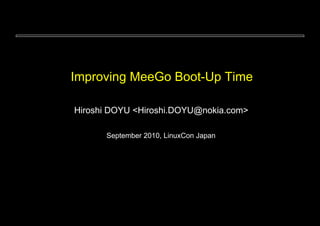
Improving MeeGo boot-up time
- 1. Improving MeeGo Boot-Up Time Hiroshi DOYU <Hiroshi.DOYU@nokia.com> September 2010, LinuxCon Japan
- 2. Preface Background Handset Boot-Up status My experiment Further optimization idea Q&A
- 3. Preface
- 4. Inspired by QuickBoot Ubiqutous QuickBoot http://www.ubiquitous.co.jp/En/products/middleware/quickboot
- 5. Embedded Linux Wiki Boot Time - eLinux.org http://elinux.org/Boot_Time
- 6. Tributed to Tim Bird Improving Android Boot-Up Time
- 7. Background
- 8. Impact of boot-up time For consumer client device User experience TV, IVI, Camera Immediate action is preferable right after power on. Tablet, netbook, handset Is cold start really necessary? More complicated S/W stacks, more memory consumed. Mass Production test The more time a device spends on the production line, the more expensive.
- 9. Boot-Up time definition Until when? When Login prompt appears. When Desktop shows up. When Network is available. When Browser is ready. When it can take a picture. When CPU goes into idle. This depends on: Your H/W configuration. Your S/W configuration. Your system requirements. The shortest isn’t always the best.
- 10. Measurement method(kernel) printk timestamps show_delta: linux-2.6/scripts/show_delta, a python script initcall debugging dmesg -s 256000 | grep "initcall" | sed "s/(.*)after(.*)/2 1/g" | sort -r -n bootgraph dmesg | linux-2.6.git/scripts/bootgraph.pl > output.svg ftrace
- 11. Measurement method(userland) uptime / # cat /proc/uptime 18.73 14.24 / # cat /proc/uptime 20.55 16.05 bootchart A newer version is released in MeeGo No additional tool to create svg. Directly created. entire measurement Including bootloader, kernel and userland grabserial show_delta, again oprofile ETM, Embedded Trace Macrocell, H/W assisted
- 12. Existing Optimization techniques kernel optimization asynchronous initcall asynchronous resume/suspend misc: preset lpj, no probe, no console, deferred module loading userland optimization initscript: upstart or systemd. Do it in parallel readahead prelink hibernation based optimization snapshot boot InstantBoot Warp2 QuickBoot BIOS/bootloader assisted.
- 13. Is cold start still necessary? Do we need cold start so often? Flashing a hibernation image in advance could reduce the production line usetime. Optimization may depend on your product specific part S/W configuration H/W configuration Your system requirement Wouldn’t hibernation be ok in most cases?
- 15. Handset requirement Responsiveness of device/applications Quick response could improve UX, especially Handsets. One touch can choose a friend from "contact list". One touch can start camera. Same as digital camera. One touch can start web browsing. A call has to be processed within a short time, from operator spec. Resolving dynamic libraries takes more time than swapping in pages. All major applications can be started but invisible Then, visible upon request. RAM is occupied with started applications/daemons.
- 16. Handset Boot-Up time N900 boot-up takes ~40 sec Until Desktop shows up. Number of applications 137 Swap status
- 19. Handset memuse
- 20. N900 Boot time breakdown Bootloader: 0.44 sec Kernel: 2.68 sec. With serial console. Could be shorter without serial console. Desktop: 39.03 sec
- 21. My experiment
- 22. Target spec OMAP3 based reference board Similar to N900 512MB RAM MeeGo Handset Number of applications ~161 ~120 sec with all application boot-up done Swap status
- 23. No hibernation support for ARM There was no hibernation support for ARM. Picked up old patch, and upgraded to v2.6.35. Rejected by RMK because: Need to be synch’ed with suspend-to-ram Lack of PXA support coprocessor differences between ARM versions mrc p15, 0, %0, c2, c0, 0 At least, it works! Let’s proceed.
- 24. Which hibernation method to use? Three implementation of hibernation 1. swsusp Included in mainline kernel as default. 2. uswsusp Userland implementation 3. tuxonice Out of kernel, but many features Compression of images multiple thread I/O readahead LVM support
- 25. Start with swsusp To start hibernation echo disk > /sys/power/state
- 26. swsusp/eMMC
- 27. swsusp/eMMC
- 28. Use mtdblock rather than eMMC mtdblock is much faster than eMMC. mtdblock ~23 MB/sec/READ eMMC ~20 MB/sec/READ ~15 MB/sec/READ This is a HACK since: mtdblock itself is bogus without wear-leveling support. mtdswap is *volatile*. Good performance But cannot be used for hibernation. Need non-volatile mtdswap!!
- 29. swsusp/MTD
- 30. swsusp/MTD
- 31. Port TuxOnIce on ARM TuxOnIce has many optimization features: Compression of images multiple threaded I/O readahead LVM support To drop pagecache echo -2 > /sys/power/tuxonice/image_size_limit To start hibernation echo disk > /sys/power/tuxonice/do_hibernation
- 32. TuxOnIce/MTD
- 33. TuxOnIce/MTD
- 34. Shrink memory before hibernation Reclaim memory as much as possible right before hibernation. echo 10000 > /sys/power/shrink_mem
- 37. What is the bottleneck? The smaller RAM consumed, the lesser boot time. But cannot squeeze any more after certain size In our case: size: ~110 MB ~70% of boot time is spent on (compressed) image restoration.
- 39. What occupies RAM? Who uses lots of memory MeeGo "memuse" can identify.
- 40. Why unevictable? Recent SoC has smart coprocessors GPU, DSP and H/W accelerators. They may have IOMMU. More memory could be shared with coprocessors http://en.wikipedia.org/wiki/IOMMU
- 41. Why does IOMMU have an effect? pages have to be DMA’able. Shared pages have to be pinned. They shouldn’t be swapped out. Unevictable
- 43. Linearity of hibernation method Linux VM tries to occupy RAM as much as possible(ex: page cache). RAM consumption can be squeezed at certain point. The boot time increases in proportion to the size of unevictable memory. For further optimization, we need something more!
- 44. Proposals 1. To increase read performance of storage Faster storage? mtd gets shorter boot-up time than eMMC faster mtd gets shorter boot-up time than slower mtd non-volatile mtdswap driver LVM swap to improve disk performance by raid-0 2. Still to decrease image size Kill & restart bloated Apps if possible. maybe a bit brutal, but it works certainly. Swap out unevictable pages How to ensure if those pages exisit when it’s necessary? page coloring memory cgroup, which process page can be swapped out 3. Lazy image/page loading Don’t we forget the system responsiveness?
- 45. Example: Ubiquitous QuickBoot Can be considered as "Lazy image/page loading": http://www.ubiquitous.co.jp/En/products/middleware/quickboot
- 46. Q&A Thank you! Please send comments toHiroshi.DOYU@nokia.com
